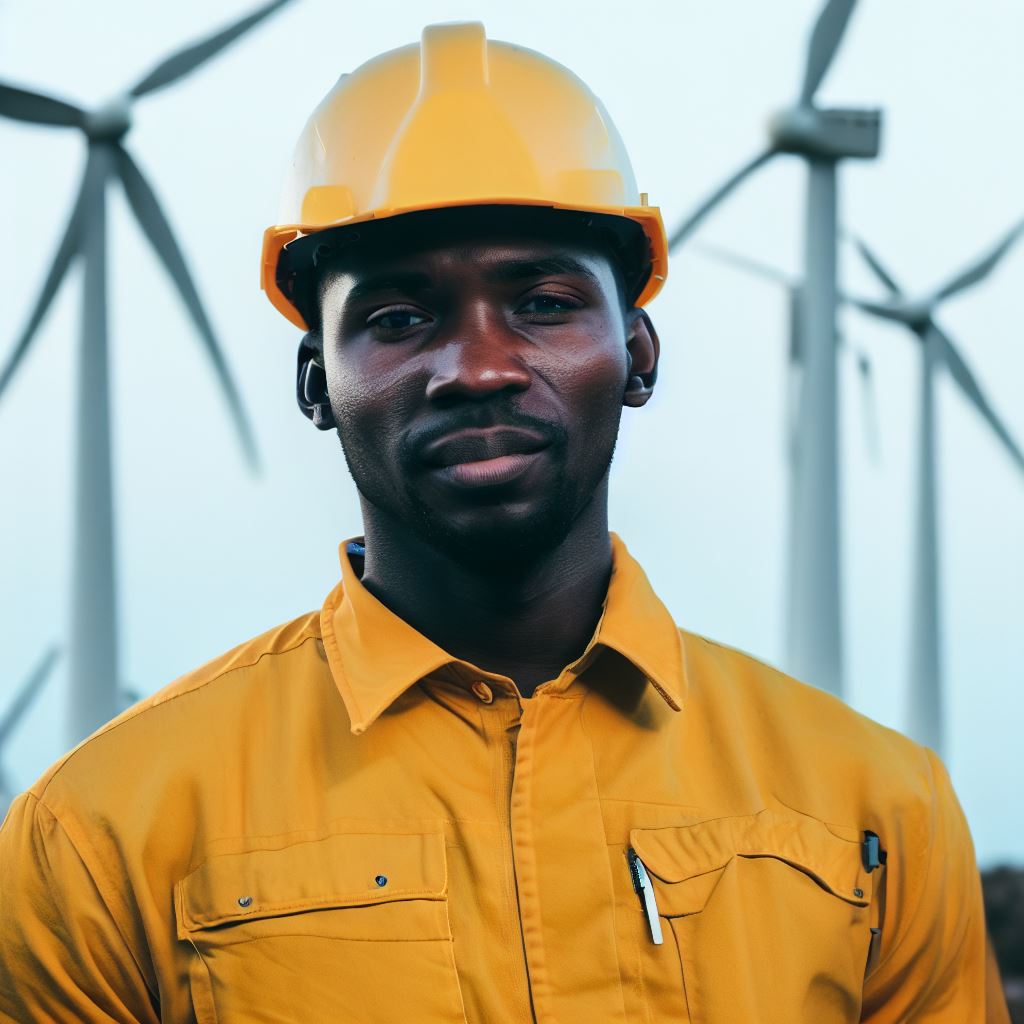Introduction
Let’s talk about wind farms locations.
Nigeria’s wind farms play a vital role in the country’s renewable energy sector.
Wind-tech opportunities in Nigeria are of great importance for the country’s sustainable development.
Briefly introduce Nigeria’s wind farms and their significance in the country’s renewable energy sector
- Nigeria’s wind farms harness wind power.
- Katsina Wind Farm is a notable example.
- They drive renewable energy growth.
- Contribute to sustainable electricity.
- Address energy needs.
Highlight the importance of wind-tech opportunities in Nigeria
- Wind-tech holds immense potential.
- Fuels economic development.
- Job creation in wind energy.
- Skills and innovation flourish.
- Reduces carbon footprint.
- Enhances energy security.
- Strengthens the green transition.
- Embrace wind-tech opportunities.
- Power Nigeria’s future sustainably.
Read: Sound Engineers: Impacting Nigeria’s Live Events
Overview of Nigeria’s Wind Farms
Existing Wind Farms in Nigeria
- Katsina Wind Farm: located in Katsina state, it is one of the largest wind farms in Nigeria.
- Ogun Wind Farm: situated in Ogun state, it has a significant capacity for generating wind energy.
- Gebba Wind Farm: positioned in Kebbi state, it plays a crucial role in the country’s wind energy sector.
- Agbami Wind Farm: found in Delta state, it contributes to Nigeria’s efforts in sustainable energy development.
Capacities and Contributions
These wind farms collectively have a total capacity of over 500 megawatts, making a valuable contribution to the national grid.
- Katsina Wind Farm alone has a capacity of 325 megawatts, producing a substantial amount of renewable energy.
- Ogun Wind Farm contributes around 100 megawatts to the national grid, supporting the electricity demand.
- Gebba Wind Farm’s capacity of 75 megawatts provides a significant portion of the energy needed in the region.
- Agbami Wind Farm, with its capacity of 20 megawatts, adds to the overall renewable energy supply in Nigeria.
Government’s Efforts
The Nigerian government has taken impressive initiatives to promote wind energy in the country.
- Establishment of favorable policies and regulations to attract investments in the wind power sector.
- Collaboration with international organizations such as the International Finance Corporation to fund wind energy projects.
- Encouragement of research and development in wind technology to enhance efficiency and sustainability.
- Support for capacity building programs to educate and train local talent for the wind energy industry.
Furthermore, the government has set renewable energy targets and aims to increase the share of wind energy in the country’s electricity mix.
The efforts also include providing incentives, such as tax breaks and grants, to both local and international companies interested in investing in wind farms in Nigeria.
In essence, Nigeria’s wind farms, including Katsina, Ogun, Gebba, and Agbami, play a significant role in the nation’s renewable energy landscape.
With their substantial capacities and contributions to the national grid, they contribute to reducing dependence on fossil fuels.
The government’s efforts in promoting wind energy further accelerate the growth of this sector, providing ample opportunities for wind-tech advancements and investments in Nigeria’s wind energy industry.
Read: The Future of Intercity Bus Travel in Nigeria: Insights
Key Locations for Wind-Tech Opportunities in Nigeria
Lagos State
- Lagos State has immense potential for wind energy development due to its coastal location and strong wind currents.
- Several ongoing wind energy projects have been planned in Lagos, including the Ikeja Wind Farm and the Lekki Wind Power Project.
Katsina State
- Katsina State possesses unique wind resources and is highly suitable for the establishment of wind farms.
- The Katsina Wind Farm, in the region, significantly contributes to the state’s economy by providing clean energy and job opportunities.
Kaduna State
- Kaduna State has great potential for wind energy generation, with its favorable wind conditions.
- The state government actively invests in wind energy infrastructure and advances initiatives like the Kaduna Wind Power Project.
Ogun State
- Ogun State has substantial wind power potential, especially in areas like Olokola and Imeko-Afon.
- Ogun State engages in significant wind energy projects like the Olokola Wind Farm and partners with global renewable energy firms.
Zamfara State
- Zamfara State possesses promising wind resources and significant possibilities for wind energy utilization.
- The government has shown support for wind technology investments through incentives such as tax breaks and subsidies for renewable energy projects.
These key locations in Nigeria offer excellent opportunities for wind technology development and investments.
Lagos State, with its coastal advantage and ongoing projects, is poised to become a major hub for wind energy in the country.
Wind farms have positively impacted Katsina State’s economy, and Kaduna State is actively harnessing wind energy potential.
Ogun State has notable wind energy projects and partnerships, making it a favorable location for renewable energy initiatives.
Zamfara State offers government support and incentives for wind technology investments, backed by its substantial wind resources.
Nigeria demonstrates its dedication to renewable energy and the potential to lead Africa in wind power generation.
Read: A Day in the Life of an Intercity Bus Driver in Nigeria

Challenges and Opportunities in Nigeria’s Wind-Tech Sector
Highlight the challenges faced by the wind energy industry in Nigeria
- Limited Infrastructure: Nigeria lacks the necessary infrastructure for wind energy projects, including transmission lines and substations.
- Inadequate Funding: Insufficient funding hinders the development and expansion of wind farms in Nigeria.
- Grid Integration Challenges: The integration of wind energy into the national grid is a complex process due to technical issues and coordination problems.
- Lack of Skilled Workforce: There is a shortage of trained professionals with expertise in wind technology, hindering project implementation and maintenance.
- Inconsistent Policy Framework: The lack of consistent policies and regulations for the wind energy sector creates uncertainty for investors and hampers growth.
Discuss potential solutions and opportunities for growth
- Government Support: The Nigerian government can provide financial incentives, grants, and tax breaks to attract investment in wind energy projects.
- Public-Private Partnerships: Collaboration between the government and private sector can help address the funding gap and spur growth in the wind-turbine industry.
- Capacity Building: Promoting educational programs and training initiatives can develop a skilled workforce capable of operating and maintaining wind farms.
- Infrastructure Development: Investment in grid infrastructure, including transmission lines and substations, is needed to support the growth of wind energy projects.
- Research and Development: Encouraging research institutions and universities to focus on wind technology can drive innovation and improve the efficiency of wind turbines.
Mention any government policies or initiatives supporting wind technology
- National Renewable Energy and Energy Efficiency Policy (NREEEP): This policy aims to increase the share of renewable energy in Nigeria’s total energy mix, including wind power.
- Incentives for Off-Grid Renewable Energy: The government provides grants and tax incentives for off-grid renewable energy projects, which includes wind technologies.
- Feed-in Tariff: The Nigerian Electricity Regulatory Commission (NERC) has proposed a feed-in tariff, ensuring that wind energy producers receive a fixed payment for the electricity they generate.
- Renewable Energy Master Plan (REMP): The REMP provides a roadmap for the development of Nigeria’s renewable energy sector, including wind energy, with the goal of increasing electricity generation and access.
In general, Nigeria’s wind energy industry faces challenges such as limited infrastructure, inadequate funding, and a lack of skilled workforce.
Government support, public-private partnerships, capacity building, infrastructure development, and research and development offer growth opportunities in the wind-tech sector.
Government policies and initiatives, like NREEEP, incentivize off-grid renewable energy, employ feed-in tariffs, and promote the REMP.
Strategic investments and a favorable regulatory environment can propel Nigeria’s wind energy sector, fostering sustainability and reducing fossil fuel dependence.
Read: Regulations and Licensing for Sound Engineers
Conclusion
This blog post highlighted key locations for wind-tech opportunities in Nigeria’s wind farms.
Wind farms and wind-tech opportunities play a crucial role in Nigeria’s renewable energy transition, contributing to a sustainable future.
Encouraging exploration and investment in Nigeria’s wind energy sector is crucial for achieving energy independence.
Summarize the key points discussed in the blog post
- Nigeria’s wind farms are burgeoning.
- Key locations harness wind power.
- Wind-tech opportunities foster growth.
- Renewable energy gains momentum.
Emphasize the importance of wind farms and wind-tech opportunities in Nigeria’s renewable energy transition
- Wind farms drive clean energy.
- Wind-tech fuels economic progress.
- Job creation and innovation thrive.
- Reduces carbon emissions.
- Enhances energy reliability.
Encourage further exploration and investment in the country’s wind energy sector
- Explore untapped wind resources.
- Invest in wind technology.
- Bolster renewable energy.
- Support sustainable development.
- Secure Nigeria’s energy future.
- Together, we power progress.




